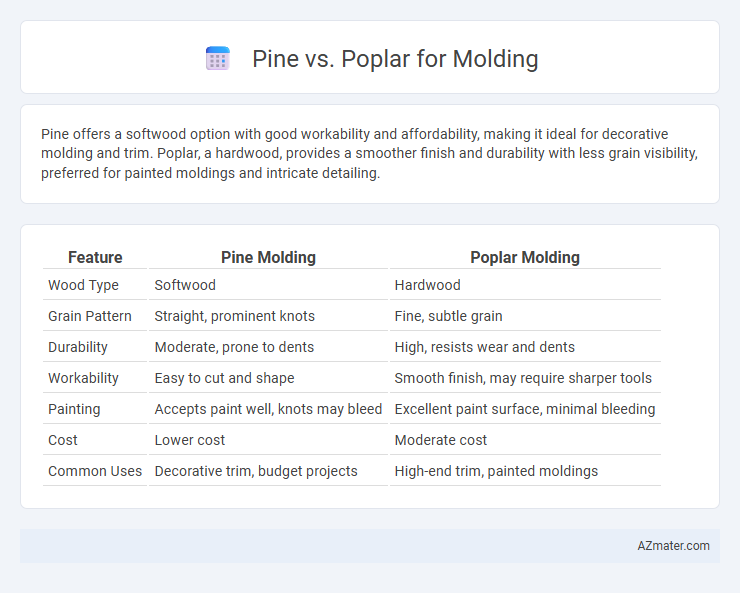Pine offers a softwood option with good workability and affordability, making it ideal for decorative molding and trim. Poplar, a hardwood, provides a smoother finish and durability with less grain visibility, preferred for painted moldings and intricate detailing.
Table of Comparison
| Feature | Pine Molding | Poplar Molding |
|---|---|---|
| Wood Type | Softwood | Hardwood |
| Grain Pattern | Straight, prominent knots | Fine, subtle grain |
| Durability | Moderate, prone to dents | High, resists wear and dents |
| Workability | Easy to cut and shape | Smooth finish, may require sharper tools |
| Painting | Accepts paint well, knots may bleed | Excellent paint surface, minimal bleeding |
| Cost | Lower cost | Moderate cost |
| Common Uses | Decorative trim, budget projects | High-end trim, painted moldings |
Introduction to Pine and Poplar for Molding
Pine and poplar are popular wood choices for molding due to their distinct properties and applications. Pine is a softwood known for its affordability, ease of workability, and attractive grain patterns, making it ideal for rustic or traditional molding styles. Poplar, a hardwood, offers a smooth texture and uniform grain that takes paint well, providing a clean and refined finish commonly preferred for contemporary molding designs.
Wood Characteristics: Pine vs Poplar
Pine wood features a soft texture with prominent grain patterns and knots, offering a rustic and natural appearance ideal for traditional molding styles. Poplar, on the other hand, has a smoother, finer grain and consistent coloration, making it easier to paint and suitable for modern, sleek molding designs. Pine's higher resin content provides natural durability, while poplar's uniform density allows for precise cutting and detailed profiles.
Durability and Strength Comparison
Pine offers moderate durability and strength, making it suitable for interior molding applications where budget and ease of workability are priorities. Poplar, while softer than pine, provides better resistance to dents and fine details due to its uniform grain, but it generally lacks the structural strength required for high-impact areas. For durable and strong molding that withstands everyday wear, pine is preferred, whereas poplar excels in projects prioritizing smooth finishes and intricate designs.
Workability and Ease of Installation
Pine offers superior workability for molding due to its soft texture, allowing easy cutting, shaping, and sanding, which makes it ideal for detailed profiles and intricate designs. Poplar, while also soft and workable, tends to be slightly harder than pine and has a finer, more uniform grain that reduces splintering during installation. Both woods install smoothly with common fasteners and adhesives, but pine's flexibility and availability often make it easier and more forgiving for beginners and quick projects.
Cost Differences Between Pine and Poplar
Pine molding generally costs less than poplar molding due to pine's faster growth rate and wider availability, making it a budget-friendly option for carpentry projects. Poplar tends to be more expensive because it offers a smoother finish and greater durability, which is preferred for painted or detailed molding work. When considering cost differences, pine is ideal for cost-sensitive projects, while poplar justifies its higher price with superior workmanship quality.
Appearance and Finishing Options
Pine molding features a prominent grain pattern with knots that create a rustic, natural look, while poplar offers a smoother, more uniform surface ideal for painting and staining. Pine's softer texture absorbs finishes unevenly, resulting in a varied appearance, whereas poplar's fine grain provides a consistent finish that highlights paint vibrancy and smoothness. Poplar's neutral color ranges from creamy white to light green, making it versatile for diverse finishes, contrasting with pine's warmer yellow to reddish hues that enhance traditional or country-style designs.
Resistance to Warping and Shrinking
Pine is less resistant to warping and shrinking compared to poplar due to its softer grain structure and higher moisture content. Poplar exhibits greater stability with minimal dimensional changes, making it more suitable for molding applications in environments with fluctuating humidity. Choosing poplar enhances durability and maintains molding integrity over time, reducing maintenance and replacement costs.
Best Applications for Pine and Poplar Moldings
Pine moldings are ideal for rustic or traditional interior designs due to their natural knots, affordability, and ease of staining or painting, making them perfect for baseboards, crown moldings, and window casings in cozy or country-style homes. Poplar moldings excel in contemporary and fine finish applications because of their smooth grain, uniform texture, and excellent paint adhesion, perfect for detailed trim work, door casings, and wainscoting where a refined, high-end look is desired. Both woods offer versatility, but Pine is preferred for budget-friendly, natural aesthetics, while Poplar suits projects requiring a clean, consistent finish.
Environmental Impact and Sustainability
Poplar molding offers a more sustainable option compared to pine due to its faster growth rate and higher yield per acre, resulting in less deforestation pressure. Pine trees generally take longer to mature, which can lead to greater environmental impact through prolonged forest resource depletion. Choosing poplar over pine for molding reduces carbon footprint and supports responsible forestry practices with lower emissions and soil erosion.
Conclusion: Choosing the Right Wood for Your Molding
Poplar offers a smooth finish and easy paintability, making it ideal for interior molding projects where a flawless painted surface is desired. Pine provides natural grain appeal and greater durability, suitable for stained moldings or areas requiring higher impact resistance. Selecting the right wood depends on whether aesthetic preference leans towards stained natural wood with character or a cost-effective, paint-ready material for seamless, modern interiors.

Infographic: Pine vs Poplar for Molding
 azmater.com
azmater.com